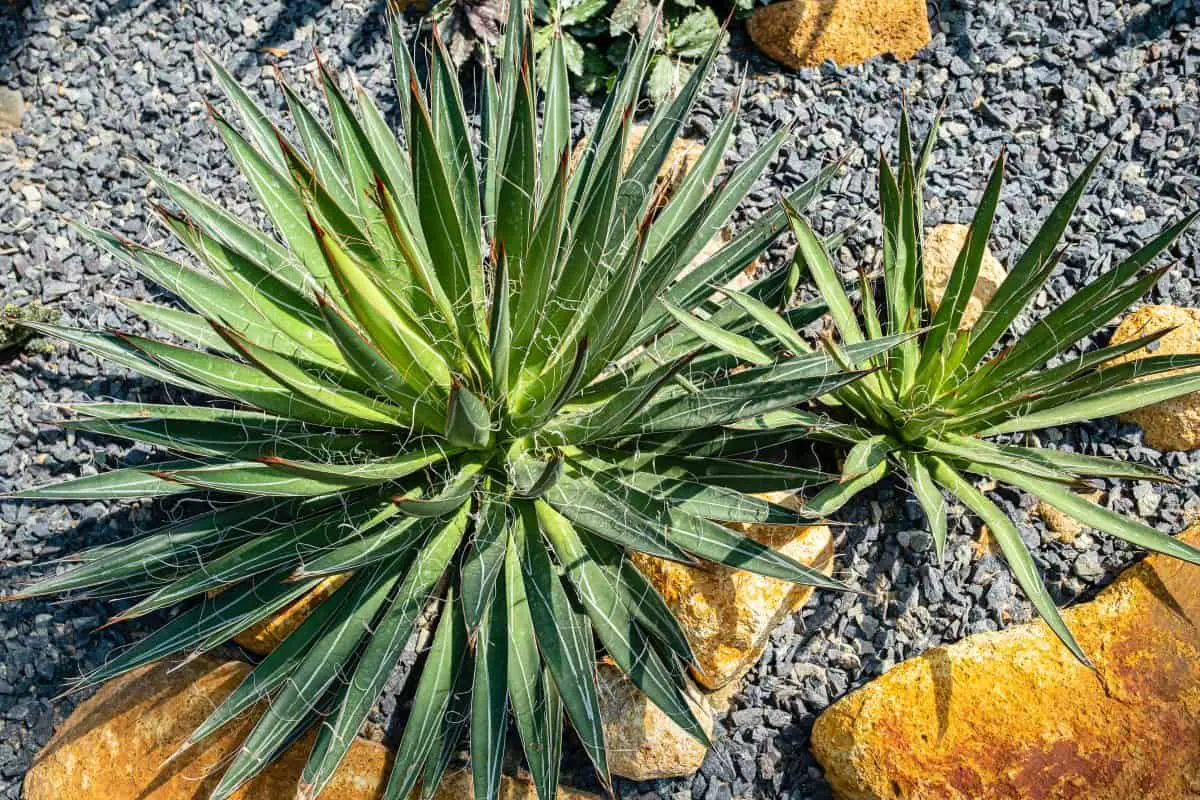A yucca and a yuca have many different traits, so they cannot be used interchangeably. Knowing these differences is important in understanding which to use.
A yucca (YUCK-ah) is a plant found in desert climates, and a yuca (YOO-kah) is a root vegetable found in tropical climates. The yucca plant is large and spiky, whereas a yuca is a thick root located under a leafy plant called cassava. Yucca and yuca can both be consumed in various ways.
Although these plants have similar names, often used interchangeably, they should not be confused with each other. We’ll go into more detail on how to tell the differences between a yucca plant and a yuca. We’ll also discuss their diverse history.
Differences of a Yucca and a Yuca Plant
The yucca plant has very sharp, spiky leaves that produce waxy flowers once or twice a year. The yucca plant’s roots are firm and white. They spread vastly underground, making yucca invasive. With many different species, a yucca plant ranges from 2 to 25 feet wide and up to 30 feet tall.
The yuca is a root from a cassava plant, a leafy plant with slim branches, which is why yuca is also referred to as cassava. The yuca has a carrot-like root that grows in clusters under the cassava. Cassava grows 14 feet tall and 10 feet wide and blooms once a year in mountainous regions. It is often grown on farmland since yuca is a food crop and is part of the spurges family.
Yucca plants are normally used as decorations inside homes or in landscaping. But a yucca can also be used in animal food and to make soap.
History of Yucca
Yucca plants are native to southern parts of the United States, South America and the Caribbean. Yuccas like dry climates like deserts with little rain and well-drained soil. The yucca plant was discovered in the late spring of 1806 by Lewis and Clark. They called the yuccas, bear grass.
Native Americans used yucca roots and trunks to make soap. They also used the coarse fibers to weave baskets and make rope. The Native Americans even fermented the fruit to create a ritual beverage.
Hey, you’ll like this one too: What Does a Yucca Symbolize
Eating Yucca Plant
If cooked, the yucca plant’s roots, seeds, and flowering stems are edible. The yucca plant has a mildly toxic sap to humans, so cooking the yucca is important. The flowers are eaten raw and have a slightly sweet taste. The fruit does not need to be cooked but is not eaten due to the tough texture and bad flavor. Red yuccas should never be consumed as they are poisonous.
Yucca plants have many health benefits when cooked and are high in vitamins and fiber that are great for people and animals. These health benefits are why yucca extract is often found in pet and livestock food. In addition, yucca provides potassium, calcium, phosphorus, iron, and copper. Yucca is also linked to better joint health, healing wounds, and restoring cartilage.
Hey, read this too: Is Yucca Healthy to Eat
History of Yuca
Yuca is native to South America but found in Asia and Africa. Yuca are found in tropical climates with warm weather and small amounts of rain. They do not tolerate cold. Freezing weather will kill the roots consequently, killing the plant. As a starchy staple, the yuca was an essential part of the Latin American and South American diet.
Yuca is still used today in food like yuca fries, yuca stew, yuca empanadas, creamed yuca, and yuca frita. Yuca is an everyday food staple that many rely on worldwide, including Africa. In Western and Central African countries, boiled yuca is pounded together to make a staple food called fufu. It is served with soups and stews.
The Latin Americans of Southern Brazil and eastern Bolivia had been eating yuca for thousands of years. In 1558 the Portuguese introduced the yuca to Africa.
Yuca was used to produce paper in the 1600s since it had the starch needed for paper pulp. When the industrial revolution began, yuca was used in the textile and adhesive industries.

Eating Yuca Root
The cassava root, called yuca, is editable. A yuca is very similar to a potato, even in taste and preparation. However, where potato skin can be eaten, a yuca skin must be removed since the skin contains cyanide. The yuca must also be boiled to remove any remaining cyanide. Once the yuca has been boiled, discard the water because cyanide remains.
Yuca is described as a light cream potato-like texture that tastes a little bitter with a hint of nut. Yuca is high in carbohydrates, a good source of resistant starch, and many vitamins like C, E, B2, and others.
Yuca also has a sweet taste. Sweet-tasting yuca is often found in the United States and is called yuca, manioc, mandioca, or Brazilian arrowroot. Yuca is often used to make flour and tapioca pudding; this is where yuca obtained another name, tapioca. The bitter, starchy-tasting yuca is usually boiled, fried, or mashed in South America or the Caribbean and made into dishes like yuca fries.
Conclusion
The yucca plant and yuca are different in plant structure, but with their similar names, they are often confused. It’s essential to know their differences because they contain poisons and should be prepared in different ways for consumption.
You can tell a yucca plant by the spiky leaves. It is also found in dry, warm climates. The yucca plant is used for landscaping, potting, and supplements. In contrast, yuca is a root from the cassava plant and is eaten as a starch once peeled and boiled. The yuca is a root of the cassava, a leafy plant that is found in warm wet climates.


